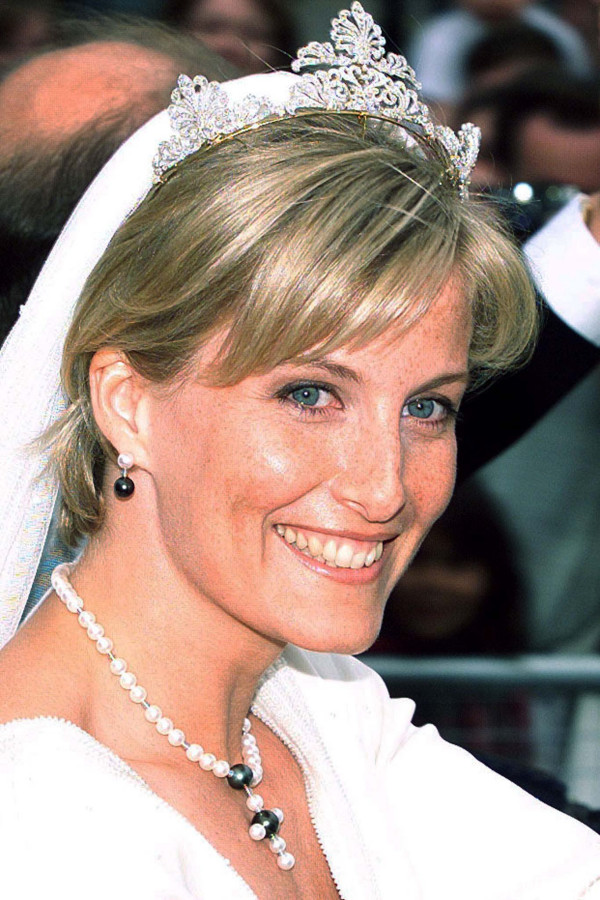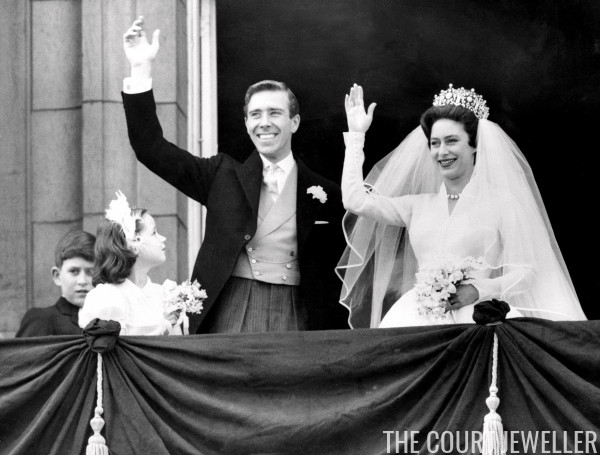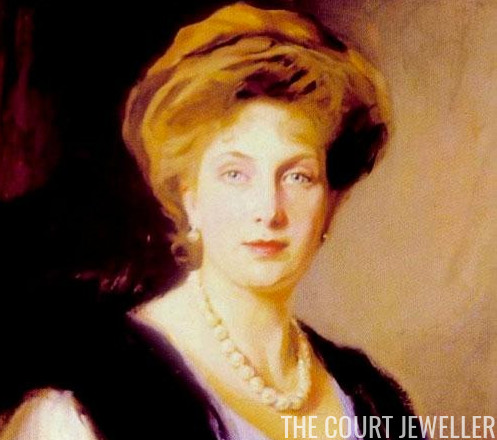 |
| Philip de Laszlo’s portrait of Queen Ena of Spain (Image: Grand Ladies Site) |
London, May 17 — Princess Henry of Battenberg [1] invited a large company to Kensington Palace today to inspect the hundreds of lovely wedding presents given to her daughter Ena [2]. The gifts were arranged on long tables around a large reception room. The jewels were shown in glass-topped cases. Princess Henry and Princess Ena stood in the center of the room, and were indefatigable in conducting their guests around and pointing out the most interesting things.
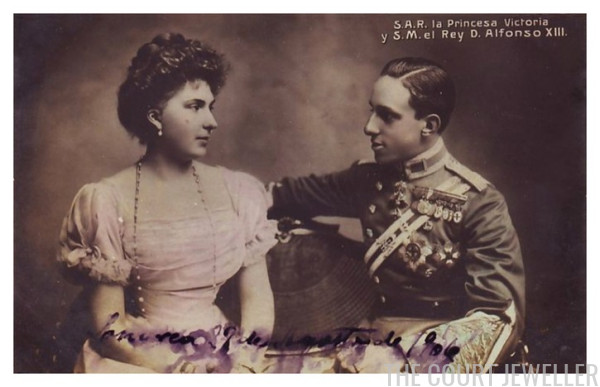 |
| Engagement portrait of Ena and Alfonso (Image: Grand Ladies Site) |
The presents from King Edward and Queen Alexandra [3] were a turquoise and diamond necklace and pendant earrings. Former Empress Eugenie [4] had given a diamond tiara [5]; the Prince and Princess of Wales, [6] a diamond ornament; Princess Henry of Battenberg, a necklace of pink pearls and diamonds [7]. Many other royal personages had given jewelry.
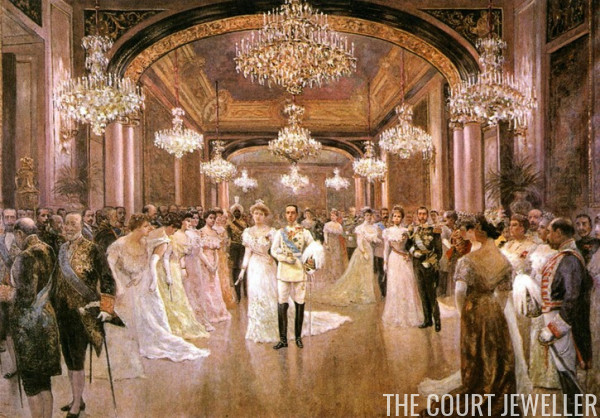 |
| Painting of Ena and Alfonso’s wedding ball by Juan Comba (Image: Grand Ladies Site) |
Ambassador Whitelaw Reid and wife’s [8] present was a large silver salver; Lord Mount Stephen [9], a diamond bow and pendant; the Duke and Duchess of Roxburghe [10], a silver bowl; William Waldorf Astor [11], a crystal box bearing the letter “E” in diamonds; Sir Thomas Lipton [12], a pianola [13]. Thirty-three aristocratic ladies gave King Alfonso a marble bust of Princess Ena.
NOTES
1. Princess Beatrice of the United Kingdom (1857-1944), youngest child of Queen Victoria and Prince Albert. Her late husband was Prince Henry of Battenberg. They had four children who survived to adulthood: Alexander, Ena, Leopold, and Maurice.
2. Princess Victoria Eugenie of Battenberg (1887-1969), always called “Ena” by her family, was the second child of Prince Henry of Battenberg and Princess Beatrice of the United Kingdom. On 31 May 1906, she married King Alfonso XIII of Spain in Madrid and became Queen Victoria Eugenie of Spain. The wedding was marred by an assassination attempt, and the marriage didn’t end up being particularly happy, but the couple had six living children. Today, their great-grandson, Felipe, is the reigning king of Spain; another great-grandchild, Sibilla, is a Luxembourgish princess.
3. King Edward VII (1841-1910) and Queen Alexandra (1844-1925) of the United Kingdom were Princess Ena’s uncle and aunt.
4. Eugénie de Montijo (1826-1920), wife of Napoleon III, was Empress of France from 1853-1871. She was also a member of the Spanish aristocracy in her own right. After the imperial couple’s exile from France, they settled in England and became close to members of the British royal family. The former empress was Princess Ena’s godmother and namesake.
5. In a July 1906 article from the New Zealand Herald, this “tiara” is described more as a diamond aigrette: “The Empress Eugenie, after whom the bride was named, and whose great favourite she has always been, selected a most uncommon and beautiful wedding gift. It was an ornament for the hair, consisting of a representation of a pair of outstretched shallow wings. The wings approach very nearly in size the normal wings of the swallow, and are composed of very fine diamonds.”
6. The future King George V (1865-1936) and Queen Mary (1867-1953) of the United Kingdom. George was Princess Ena’s first cousin.
7. Here’s the New Zealand Herald‘s extended description of Princess Beatrice’s gifts to her daughter: “The bride’s mother, Princess Henry of Battenberg, gave exquisite lace and a case of jewels containing a tiara of pink pearls and diamonds and a necklace to match. All the presents from Her Royal Highness to her daughter attracted notice and keen admiration.”
8. Because this article is from the Washington Post, we get extra attention to the gifts given by Americans. Whitelaw Reid (1837-1912) was the American ambassador to the United Kingdom from 1905 until his death in 1912; his wife, Elisabeth Mills Reid, was a key figure in American expatriate social circles in London.
9. George Stephen, Baron Mount Stephen (1829-1921) was a prominent Canadian businessman and philanthropist. In 1891, he became the first Canadian to be elevated to the peerage when he was created Baron Mount Stephen by Queen Victoria. His second wife, Gian, was a close friend of Queen Mary; she gave Mary a diamond riviere necklace that later belonged to Princess Margaret (and was sold in the 2006 auction of her jewels).
10. Henry Innes-Ker, 8th Duke of Roxburghe (1876-1932) and Mary, Duchess of Roxburghe (1878-1937), nee Mary Goelet. She was one of the wealthiest of the American heiresses to marry into the British aristocracy during the era of the “Buccaneers.”
11. William Waldorf Astor (1848-1919) was an American-born businessman and politician who became a naturalized British subject in 1899. After inheriting his father’s fortune in 1890, he became the richest man in America; soon after, he built the Waldorf Hotel. He was created Baron Astor, and then Viscount Astor, during World War I. In May 1906, he also lavished an astonishing piece of jewelry on his new daughter-in-law, Nancy, as a wedding gift: the Sancy Diamond, set in a large tiara.
12. Sir Thomas Lipton, 1st Bt. (1848-1931) was the Glasgow-born founder of Lipton Tea. He was a friend of both King Edward VII and King George V, with whom he shared a passion for yacht racing.
13. This new-fangled gift was a player piano, which automatically played music from sheets or rolls.
